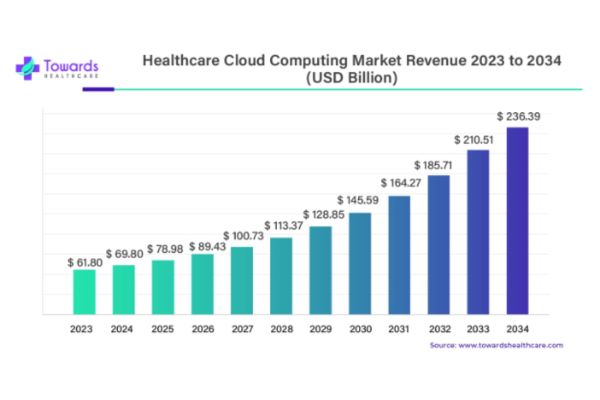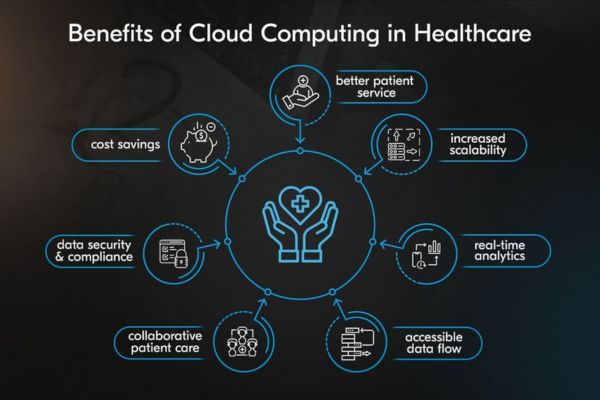Various services provided over the internet with the help of computing resources come under cloud computing. The cloud computing resources include infrastructure, storage, software, tools, etc.
The healthcare cloud computing market provides these resources to the healthcare industry for various operations. With a growing number of patients, healthcare infrastructure, staff and patient data, financial data, etc., a large number of data is generated and handled on a daily basis. It can become quite challenging to store and manage data on local devices, which is why cloud computing has become a necessary part of the healthcare system.

The global healthcare cloud computing market size was estimated at US$ 61.80 billion in 2023 and is projected to grow to US$ 236.39 billion by 2034, rising at a compound annual growth rate (CAGR) of 13.05% from 2024 to 2034.
Storing and using data on personal devices can slow down the systems, which becomes a very big issue when providing healthcare. Therefore, cloud computing has become a necessary tool for the smooth flow of various operations that are conducted in the healthcare sector.
How can AI Improve the Healthcare Cloud Computing Market?
Cloud AI is an innovative combination of technology. By combining AI with cloud computing, businesses may easily integrate AI tools, algorithms, and cloud services into their daily operations. One of Cloud AI’s main advantages is its ability to analyze large datasets quickly and effectively. This capability helps machine learning.
algorithms to find hidden patterns and insights in massive data repositories, which is very helpful in data-center sectors like healthcare.
Benefits of Cloud Computing in Healthcare
1. Enhanced Data Security
Cloud computing provides robust security frameworks that safeguard sensitive patient information. Healthcare data breaches can be catastrophic, but the cloud’s sophisticated encryption, multi-factor authentication, and continuous monitoring tools help mitigate risks, ensuring data remains protected from unauthorized access.
2. Improved Healthcare Services
By enabling real-time access to patient data, cloud solutions allow healthcare providers to deliver personalized and efficient care. Cloud platforms support electronic health records (EHRs), telemedicine, and other critical services, which streamline workflows, reduce errors, and improve overall patient care.
3. Cost Efficiency
Cloud computing helps healthcare organizations save costs on infrastructure, storage, and maintenance. Instead of investing heavily in on-premises servers and data centers, healthcare providers can leverage the cloud’s pay-as-you-go model, reducing capital expenditure and operational costs.
4. Support for IoMT
The Internet of Medical Things (IoMT) is transforming healthcare by connecting medical devices to the cloud for real-time monitoring and data analysis. Cloud computing facilitates IoMT solutions, which improve patient outcomes, enhance care efficiency, and provide timely interventions.
5. Enhanced Patient Engagement
Cloud solutions offer secure, real-time access to medical records, allowing patients to actively participate in their healthcare journey. This transparency fosters trust, improves patient satisfaction, and encourages better health management practices.
High-Speed Internet Can Promote the Market
The healthcare cloud computing market runs on cloud-based systems that need a good internet connection for data management and storage. Therefore, having high-speed internet can enhance cloud-based systems even more. The broadband platform of the future, known as 10G, will provide higher speeds, reduced latency, and increased capacity and dependability to many users—not just the handful at the end of individual fiber installations by some businesses. 10G will provide dependability and security while enabling artists and innovators to realize their ambitions thanks to increased power and capacity.
Strong IT Presence Favors North America’s Market
North America dominated the healthcare cloud computing market share by 46% in 2023. North America has countries like the U.S. and Canada, which are known for technological advancements not just only in healthcare but also in information technology. These advancements promote the use of cloud-based systems in the healthcare industry, leading to better data management. Governments also support cloud-based systems and the healthcare industry by developing new programs and providing financial support.
The U.S. led North America’s healthcare cloud computing market. The major contributors to the growth are the growing prevalence of diseases, government support, the advanced IT sector, advanced healthcare infrastructure, and growing awareness about the use of cloud-based systems in healthcare.
Growing Healthcare Industry Promotes Asia Pacific’s Market
Asia Pacific is expected to grow at the fastest rate during the forecast period. With the growing population in the Asia Pacific region, the number of patients is also increasing. These factors contribute to the development of new healthcare infrastructure. All these factors contribute to the growth of the healthcare cloud computing market due to increased data associated with staff, patients, facility management, financial data, and any other data that is generated in the healthcare sector.
The Future of Cloud Computing in Healthcare
The future of cloud computing in healthcare is poised for significant growth, driven by technological advancements and increasing adoption across the industry. Key trends shaping the future include:
1. Remote and Decentralized Care Models
The shift towards remote care will continue, fueled by cloud-based platforms that support telehealth services, virtual consultations, and remote patient monitoring. These models will improve access to care, especially in underserved areas.
2. Advanced Security Measures
Cloud providers will implement more sophisticated security measures, including AI-driven threat detection, blockchain for secure data transactions, and zero-trust security models to safeguard sensitive healthcare data.
3. Expansion of IoT and IoMT
The proliferation of IoT and IoMT devices will continue, enabling real-time data collection, remote monitoring, and improved patient care. Cloud computing will play a critical role in managing and analyzing this vast influx of data.
4. Edge Computing for Real-Time Processing
Edge computing will become more prevalent, allowing data processing closer to the source and reducing latency. This will enhance the performance of critical healthcare applications like telemedicine and remote surgeries.


















